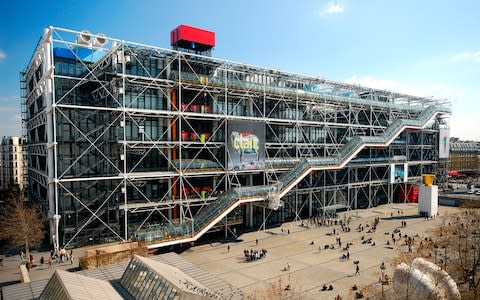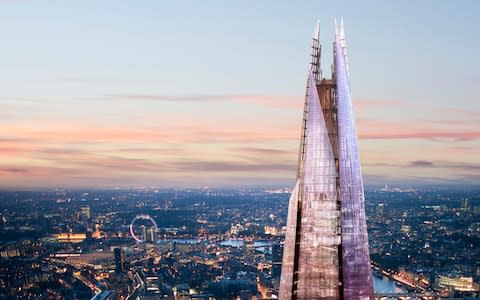How Renzo Piano changed the world

When it opened in 1977, the Pompidou Centre gave Paris a new heart. I know, because a couple of years later, when I visited the city for the first time, that was the building I wanted to see. Not the Eiffel Tower, nor the Arc de Triomphe, not even the Tour Montparnasse.
Such was the Pompidou’s instant reputation for architectural daring, for its multicoloured, inside-out construction, its escalators which rose in diagonal tubes, the cool modern art housed inside and the even cooler public performance space in front, that it was the first place that any self-respecting teenager like me wanted to visit.
In Britain it was Richard Rodgers who got the most high-profile credit for its design. In fact, it was a joint project with his Italian partner, Renzo Piano. After Pompidou they remained close friends, but they went their separate architectural ways, and much of Piano’s solo work since has been just as high-profile as the Pompidou, and of just as much interest to travellers.

Over the last 40 years he has designed hotels (including London’s Shard), concert halls, an airport, and more than a dozen museums – a prolific output which is currently being celebrated in a new Royal Academy exhibition.
Ahead of the opening, I met Piano at his workshop on the outskirts of Genoa, a few weeks before the tragic collapse of the Morandi Bridge. It’s an idyllic location, overlooking the Mediterranean and features the Renzo Piano Foundation which contains a museum of the models, drawings and mock-ups of the buildings which have defined his career. It tracks his work chronologically from 1966 right up to the present day and I spent some time there trying to get my head around how these radical, highly-imaginative buildings – with their soaring masts and towers, their sweeping curves and dislocated structures – related to his aesthetic roots.

Genoa, after all, has a remarkable architectural heritage. There are great medieval buildings like the cathedral, but there was also a huge economic boom in the 16th century when prosperous families rebuilt their palazzi in classical Renaissance style.
But when I try to coax out of him whether or how these extraordinarily beautiful buildings had influenced his work, he is reluctant to be drawn. He admits to being “in love with the stone of Genoa” and that the concept of the piazza is central to his work: it is “one of the founding icons of the city”. “There is something Italian in what I’m doing,” he goes on, and he agrees that classical ideas of proportion and balance are important. But he won’t be tied down to specifics. “Architecture is about harmony, beauty, poetry – it may come from light, suspension, and language and expression,” as well as other buildings.

Piano does concede that: “All art is about robbery – about stealing and giving back.” And he has certainly done some giving back in Genoa. One of his most subtle and perhaps most effective projects was the redevelopment of the city’s waterfront in 1992. He cleared some of the derelict buildings which formed a barrier city and port and rejuvenated the quaysides, warehouses and open spaces of the old docks. Now it is a new waterside piazza for the city – a place for passeggiata, entertainment and eating out. His final contribution may well be a new bridge to replace the Morandi – he has already offered his help to the city in its hour of need.

So, while I came away still unclear about the connections between contemporary architecture and the great buildings of the past, I certainly had my eyes opened to Genoa. Since my visit it has seen tragedy. But it is a great city, much overlooked in favour of its more famous Italian neighbours. Though it suffers from occasional waves of day-trippers from the cruise-ship dock, its day-to-day rhythms are largely unaffected by tourism.

Walk into a restaurant in Florence or Venice and you will be surrounded by other tourists, while the waiters will have commuted in from distant suburbs. Here, once you have negotiated the throngs of the old town’s thriving passeggiata, there is a good chance you will sit down at a table and be told that the menu is in Italian only. In the days when the centres of so many historic cities have lost their souls and surrendered to the ever-rising tide of tourism, Genoa’s heart is still beating.
Renzo Piano: The Art of Making Buildings is at the Royal Academy (royalacademy.org) from Sept 15- Jan 20 2019.
Essentials
BA (ba.com) flies to Genoa from Gatwick and Ryanair (ryanair.com) from Stansted. The Renzo Piano Foundation in Genoa is open to visitors on occasional Saturdays (September 29 and October 6 are the next). Booking is essential via (fondazionerenzopiano.org). For more information on the city (visitgenoa.it). Nick Trend stayed in the four-star Hotel Palazzo Grillo (hotelpalazzogrillo.it), a converted 16th-century palazzo. Doubles from about £200 per night.


